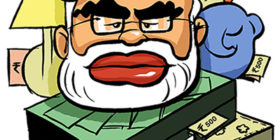In his celebrated treatise, the Kautilya Arthashastra, Chanakya has delved at length on why and how a conqueror should go to war. “To neutralise the enemy-in-the-rear, to help an ally or to subdue a small state, and the ultimate objective is to destroy the natural enemy who is an obstacle to the conqueror’s ambition,” he says.
Cut to the present, if Prime Minister Narendra Modi is the conqueror with an ambition to build a prosperous and equitable India, the hoarders of illegal wealth are the natural enemy. In running for the office that he occupies , Modi promised a war on black money and that the booty won would be distributed among the poor and the needy. The most dramatic offensive in that war came on November 8, with the scrapping of 500 and 1000-rupee notes in circulation — a move that has since split the nation between those who see this as a game changer for India’s economy and the others who dismiss it as a political gimmick that will inflict more economic pain. It will take several months, or more, to figure out which side wins the argument. But we know a few things about the art of warfare that decide if a war will be won or lost.
To take a cue from the Arthashastra again, “planning for battle” is as critical to winning a war as its objective. Three weeks on, it is evident that the government’s offensive on dodgy cash came without adequate planning. The chaos that followed and the frequent changes to the rules relating to the use, exchange and withdrawal of cash — some of which are now being challenged for their legal validity — bear it out.
New rules, brought in almost with a daily frequency, have plugged existing loopholes only to create new windows for people with illegal cash to escape. At the last count, more than half of the Rs 14.2 lakh crore held in denominations of 500- and 1000-rupee notes had returned to the banking system. With more than a month to go for the December 30 deadline for depositing banned notes, it would be fair to expect that all but a small proportion of the cash in high denominations will return — termed legal.
Such a scenario upsets the government’s initial game plan. It was hoping that a substantial part of the Rs 14.2 lakh crore would not return to the banking system. That would have significantly cut the liability on the books of the RBI, added to its profits and allowed it to boost money supply in a non-inflationary manner by printing new notes against the cash that didn’t return to the system. Interest rates would have softened and economic growth would have accelerated in the longer term, which in turn would have made the short-term pain appear worth taking. Many policy makers are unsure if the script holds as good as it looked earlier.
It appears now that the prime minister’s bold initiative runs the risk of getting derailed because the government machinery has failed him.
Worse, in their attempt to make up, the authorities charged with the responsibility of executing the plan are creating a new imagery of the enemy. They are training their guns on holders of Jan Dhan accounts , who might have been lured by small-time traders, contractors or local politicians to be a conduit in converting illegal cash into legal.
Previously, they came up with the idea of indelible ink to prevent wage earners from exchanging the cash of others for a paltry commission of a few hundred rupees. In this, one has lost sight of the real enemy in the war on black money — the habitual tax offenders, the big loan defaulters who continue to rob our banks, and the rich and mighty who have stashed their wealth away in non-cash assets and tax havens overseas. Instead, the needle of suspicion in this war has moved to the poor and the exploited. To quote Chanakya again, the conqueror must know the enemy’s enemy is an ally and not an enemy.






Leave a reply